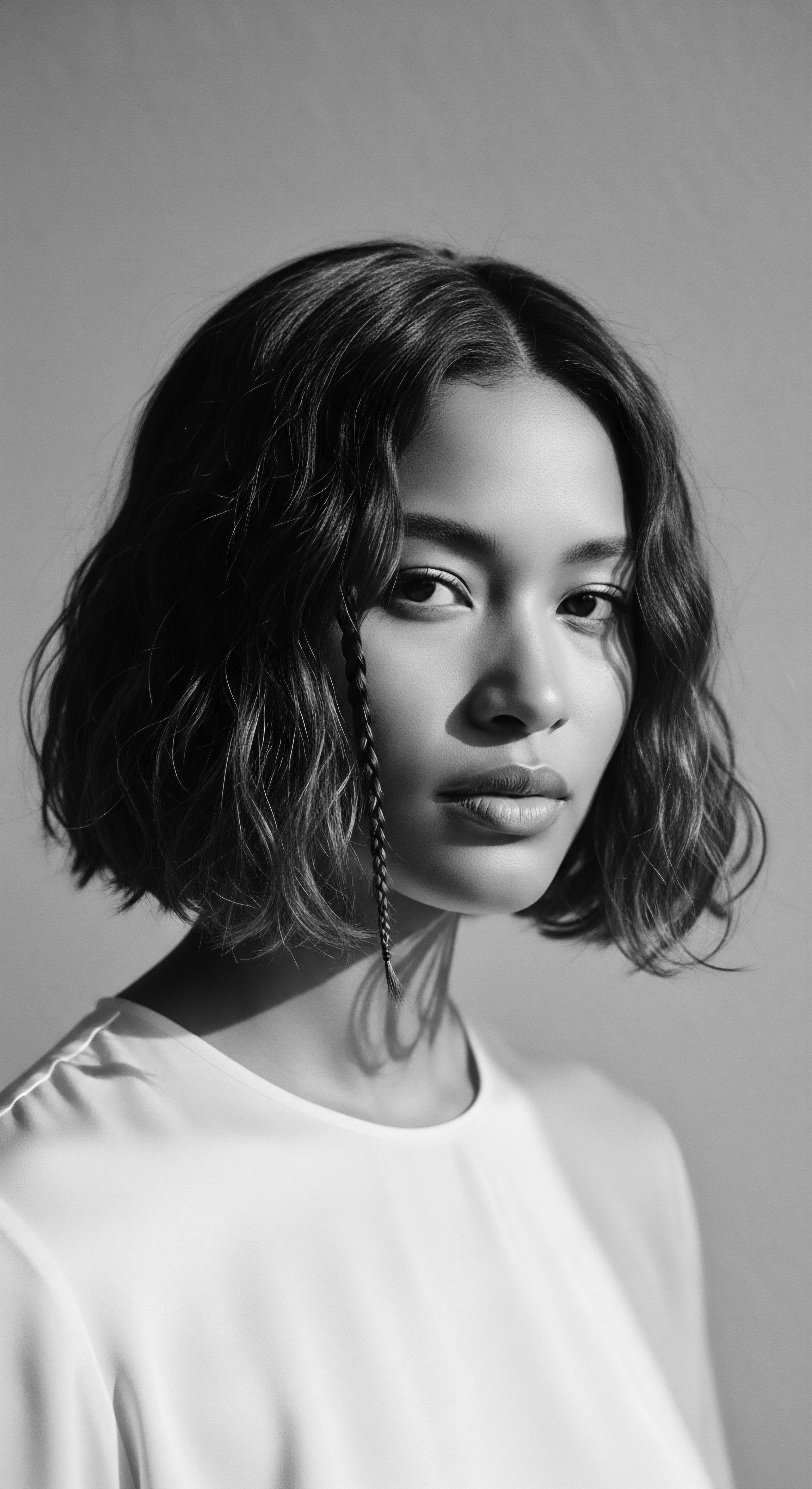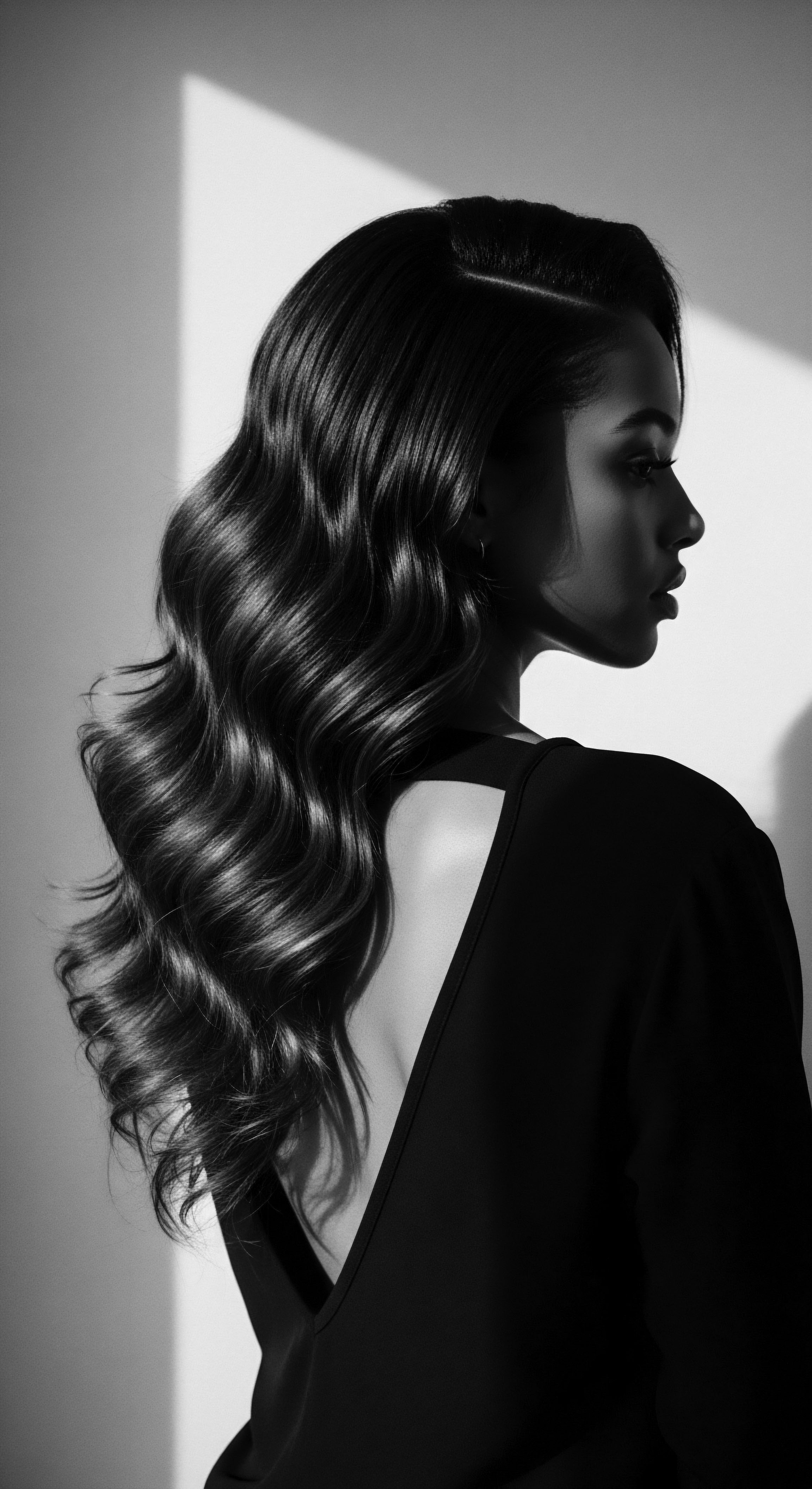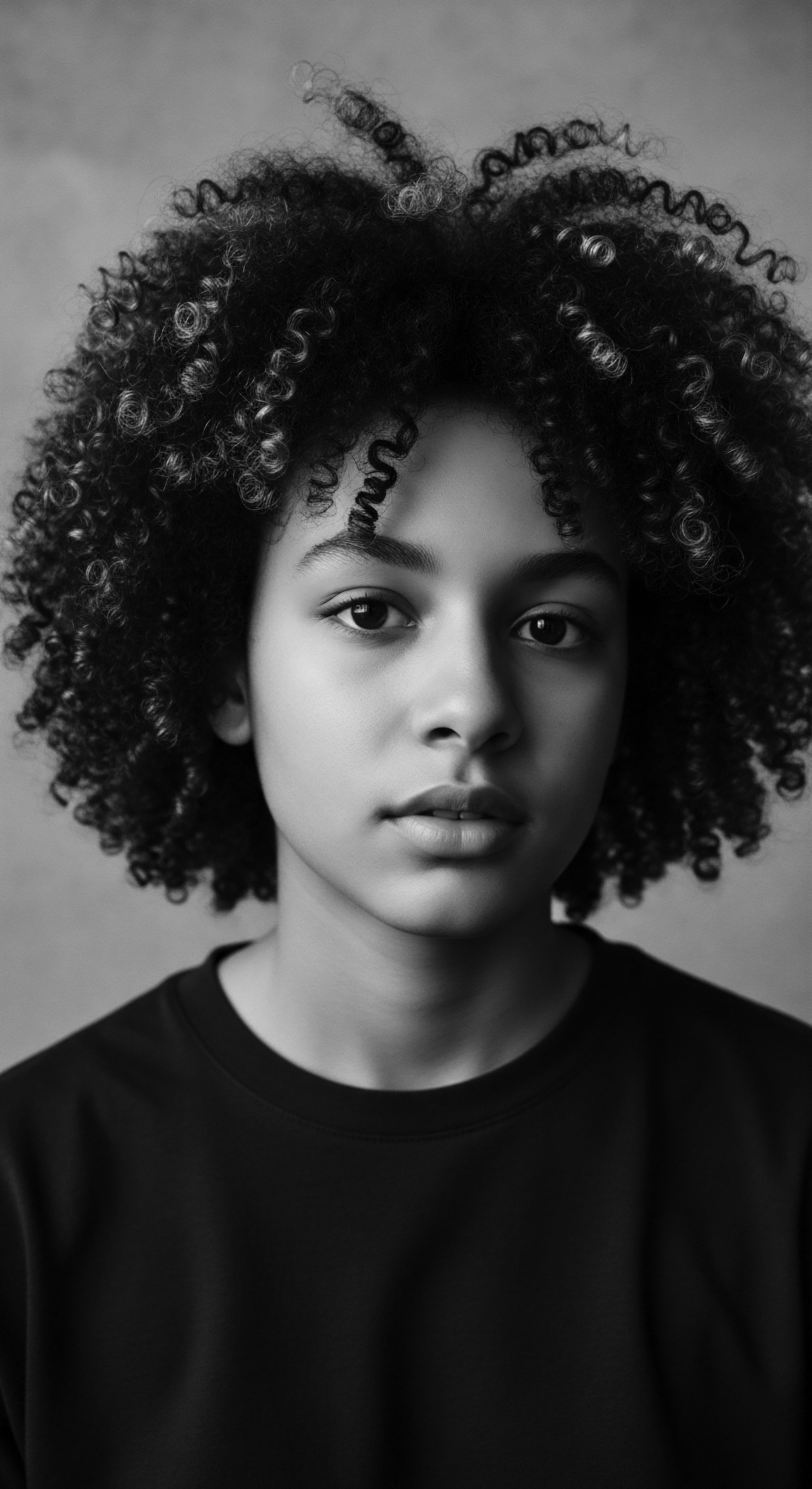
Fundamentals
Textured Hair Nourishment, within the expansive living library of Roothea, signifies far more than a simple application of products. It represents a profound engagement with the very life force of coily, kinky, and wavy strands, recognizing them not merely as biological structures but as carriers of ancient stories, enduring resilience, and cultural legacy. At its foundational core, this concept speaks to the systematic provision of essential elements that allow textured hair to flourish in its innate splendor, honoring its unique architecture and historical journey. The initial interpretation of nourishment extends to providing deep moisture, fortifying strength, and encouraging vibrant vitality from root to tip, fostering a symbiotic relationship between care and heritage.
The true meaning of Textured Hair Nourishment is an acknowledgment of hair as a living extension of self, a sentiment deeply embedded in ancestral wisdom. It is about understanding the hair’s inherent need for hydration, which, for many textured patterns, is a continuous quest due to the distinctive coiling of the strand that can hinder the natural flow of sebum down the hair shaft. Beyond simple hydration, it encompasses the replenishment of lipids, the structural integrity provided by proteins, and the soothing of the scalp, which serves as the fertile ground from which these magnificent strands emerge. This elemental approach to care, while seemingly straightforward, is steeped in practices passed down through generations, long before scientific terms articulated their efficacy.
Textured Hair Nourishment is a foundational commitment to the well-being of coily, kinky, and wavy strands, rooted in ancestral wisdom and the inherent needs of their unique structure.
To comprehend this nourishment, one must consider the hair fiber’s morphological distinctiveness. Unlike straight hair, the elliptical or flattened cross-section of textured hair, coupled with its often irregular curvature, creates points of vulnerability along the shaft. These points are prone to breakage and moisture loss, making the thoughtful delivery of moisturizing and strengthening agents paramount.
Ancestral communities intuitively understood these vulnerabilities, developing remedies from their immediate environments that served as powerful emollients and protective balms. This intuitive understanding forms the bedrock of our contemporary approach to Textured Hair Nourishment, serving as a testament to the timeless wisdom embedded in heritage.

The Echoes of Early Care
The earliest forms of Textured Hair Nourishment were born from observation and necessity. Indigenous communities across Africa, and later within the diaspora, cultivated an intimate knowledge of their local botanicals and natural resources. These were not merely cosmetic applications; they were rituals of survival, protection, and cultural expression.
The very act of cleansing and oiling hair became a communal activity, strengthening social bonds and preserving identity amidst challenging circumstances. This historical context provides a profound significance to the simple act of nourishing textured hair today.
- Hydration Rituals ❉ Early care practices often centered on water-based rinses and the application of natural humectants derived from plants, ensuring moisture was drawn into the hair shaft and held there.
- Protective Layers ❉ Butters and oils, extracted from indigenous plants, formed a protective barrier against environmental stressors, sealing in moisture and adding a sheen that signified vitality.
- Scalp Wellness ❉ Traditional remedies frequently addressed scalp health, recognizing it as the source of healthy hair growth, using herbal infusions and gentle massages to promote circulation and cleanliness.

Intermediate
Stepping beyond the foundational principles, the intermediate understanding of Textured Hair Nourishment delves into the intricate interplay of biological requirements and the living traditions of care that have sustained textured hair through epochs. It acknowledges that true nourishment is a dynamic process, one that adapts to the hair’s evolving needs while remaining tethered to its ancestral roots. This expanded interpretation recognizes that the efficacy of care rituals often hinges on the precise delivery of specific components, whether they are naturally occurring or scientifically refined.
The hair shaft, a complex protein filament, requires a balanced infusion of elements to maintain its structural integrity and flexibility. For textured hair, which can exhibit a greater propensity for dryness and fragility due to its helical configuration and fewer cuticle layers that lay flat, the consistent provision of both water-soluble and oil-soluble emollients becomes a continuous dialogue with the strand. This ongoing conversation addresses the hair’s inherent thirst, preventing the desiccation that can lead to brittleness and fracture. The goal is not merely to coat the hair but to permeate its layers, delivering sustenance that resonates with its deepest needs.
Textured Hair Nourishment at an intermediate level recognizes the dynamic interplay of biological needs and ancestral practices, emphasizing precise component delivery for sustained hair health.

The Tender Thread ❉ Ingredients and Intent
Traditional hair care practices, often dismissed as rudimentary, were in fact sophisticated applications of ethnobotanical knowledge. Communities intuitively grasped the functional properties of various plants and their extracts. For example, the mucilaginous properties of certain plants, like okra or hibiscus, were utilized to provide slip and moisture, a function now understood scientifically as the action of polysaccharides and glycoproteins. These historical preparations implicitly delivered humectants, emollients, and even mild cleansing agents, demonstrating a deep, inherited understanding of hair’s requirements.
The practice of hair oiling, prevalent across numerous African communities, serves as a powerful example of this intermediate understanding. Oils such as shea butter, palm oil, and coconut oil were not randomly chosen. They were selected for their ability to penetrate the hair shaft, seal moisture, and impart a protective sheen.
This purposeful application, often accompanied by gentle manipulation like braiding or twisting, minimized tangling and breakage, preserving the hair’s length and vitality over time. The communal aspect of these rituals further enhanced their efficacy, transforming a practical need into a cherished social occasion.
Understanding the meaning of nourishment for textured hair also involves recognizing the historical context of its care, particularly during periods of forced displacement and cultural suppression. Despite the brutal attempts to strip away identity through hair shaving and the denial of traditional tools, enslaved Africans and their descendants ingeniously adapted, utilizing available resources to continue their hair care practices. The use of rudimentary tools and often harsh substances to mimic Eurocentric styles emerged from a desperate need for survival and acceptance, yet simultaneously, acts of resistance persisted through the quiet preservation of traditional braiding patterns and the resourceful application of natural ingredients. This resilience underscores the profound connection between hair, heritage, and the enduring spirit of self-preservation.
The scientific understanding of hair structure, particularly the distinction between hair types, has been a relatively recent development in mainstream cosmetology. However, the lived experiences of textured hair communities have always informed a practical, albeit uncodified, science of nourishment. The recognition that coily hair, with its unique helical twists, possesses a higher susceptibility to mechanical damage and moisture loss, necessitates specific conditioning and protective strategies. This reality was implicitly understood and addressed through generations of hands-on care.
| Nourishment Aspect Moisture Retention |
| Ancestral Practice (Heritage) Applying mucilage from plants (e.g. okra, hibiscus) or water-rich fruit pulps. |
| Contemporary Understanding (Science) Utilizing humectants (glycerin, hyaluronic acid) and occlusives (heavy oils, butters) to attract and seal water. |
| Nourishment Aspect Strength & Elasticity |
| Ancestral Practice (Heritage) Infusions of strengthening herbs, protein-rich plant extracts, or animal fats. |
| Contemporary Understanding (Science) Incorporating hydrolyzed proteins (keratin, wheat protein) and amino acids to reinforce the hair's cortex. |
| Nourishment Aspect Scalp Health |
| Ancestral Practice (Heritage) Massaging with antimicrobial oils (e.g. neem) or herbal decoctions to cleanse and soothe. |
| Contemporary Understanding (Science) Employing anti-inflammatory agents, prebiotics, and essential oils to balance the scalp microbiome and reduce irritation. |
| Nourishment Aspect Protection |
| Ancestral Practice (Heritage) Braiding, twisting, and wearing headwraps to shield hair from environmental elements. |
| Contemporary Understanding (Science) Using leave-in conditioners, heat protectants, and styling techniques that minimize friction and environmental exposure. |
| Nourishment Aspect The enduring wisdom of ancestral practices often finds validation in modern scientific insights, affirming a continuous lineage of hair care knowledge. |

Academic
Textured Hair Nourishment, from an academic perspective, represents a multidisciplinary concept, demanding a rigorous examination that spans the realms of trichology, ethnobotany, cultural anthropology, and socio-economic studies. Its meaning extends beyond superficial cosmetic enhancement, probing the biological imperatives of hair fiber, the historical evolution of care practices, and the profound socio-cultural implications of hair within Black and mixed-race communities. This comprehensive elucidation acknowledges the unique structural and physiological characteristics of textured hair, recognizing how these attributes necessitate specific care regimens that have, for millennia, been intuitively developed and transmitted through ancestral knowledge systems.
The fundamental understanding of Textured Hair Nourishment rests upon the unique morphology of coily and kinky hair strands. These hair types typically possess an elliptical or flattened cross-section, and their helical growth pattern results in numerous twists and turns along the shaft. These structural characteristics contribute to a higher susceptibility to dryness and mechanical damage compared to straight hair, as the natural sebum produced by the scalp struggles to traverse the entire length of the highly coiled strand.
Furthermore, the cuticle layers, which serve as the hair’s protective outer sheath, may not lie as flat in textured hair, creating more opportunities for moisture loss and protein efflux. Consequently, the core objective of Textured Hair Nourishment is to counteract these inherent vulnerabilities by optimizing hydration, bolstering structural integrity, and mitigating external stressors.
Academic understanding of Textured Hair Nourishment is a multidisciplinary inquiry into the unique biology of coily strands, the enduring wisdom of ancestral care, and the profound socio-cultural significance of hair in Black and mixed-race communities.

Echoes from the Source ❉ The Ancestral Pharmacopoeia
The ancestral practices of hair care, often rooted in specific ethnobotanical traditions, represent a sophisticated form of applied science. Before the advent of modern chemistry, communities meticulously observed and utilized the properties of local flora to address the specific needs of textured hair. This deep ecological intelligence, passed down through oral traditions and communal rituals, constituted a veritable pharmacopoeia of natural emollients, humectants, and fortifying agents.
For instance, the widespread use of shea butter (Vitellaria paradoxa) across the “Shea Belt” of West Africa stands as a compelling testament to this inherited wisdom. This natural fat, extracted from the nuts of the shea tree, is rich in fatty acids, vitamins A and E, and triterpenes, which collectively provide exceptional moisturizing, anti-inflammatory, and protective properties.
The processing of shea butter, traditionally a labor-intensive activity predominantly undertaken by women, is not merely a utilitarian task but a deeply ingrained cultural practice. It is a process that begins with the collection of fallen shea fruits, followed by drying, crushing, roasting, and hand-kneading the nuts to extract the butter. This meticulous method, refined over centuries, yields a product whose efficacy for skin and hair care has been recognized for millennia, with historical accounts even linking its use to figures like Cleopatra. The term “women’s gold,” often used to describe shea butter, reflects its economic significance as one of the few commodities in West Africa largely controlled by women, providing a vital source of income and economic independence for millions.
A study conducted by the International Trade Centre (ITC) in 2016, as cited in research on the economic empowerment of female shea actors, highlighted that the majority of shea butter producers in West Africa are women, and their engagement in the production and marketing of shea products significantly enhances their livelihoods, leading to increased incomes and greater involvement in household decision-making (ITC, 2016, as cited in Yaro et al. 2024, p. 2).
This specific historical and economic context underscores how Textured Hair Nourishment, through the lens of shea butter, is inextricably linked to the agency, resilience, and socio-economic well-being of African women, moving beyond a mere beauty practice to a profound act of cultural and economic self-determination. The income generated from shea butter production has, for generations, supported families, paid for children’s education, and provided a measure of autonomy in often challenging economic landscapes.

The Unbound Helix ❉ Identity and Resistance through Care
The history of textured hair nourishment is also a narrative of resistance and identity preservation, particularly within the context of the transatlantic slave trade and subsequent colonial pressures. Upon forced arrival in the Americas, enslaved Africans were often stripped of their traditional hair tools, ingredients, and the communal time for grooming, an act intended to dehumanize and erase their cultural identity. Despite these oppressive conditions, acts of hair care persisted as subtle yet powerful forms of defiance. Enslaved women would ingeniously utilize whatever was available—such as butter, bacon fat, or goose grease for straightening, or even braiding rice seeds into their hair for survival—demonstrating remarkable adaptability and an enduring connection to their ancestral practices.
The concept of “good hair” versus “bad hair,” a damaging legacy of slavery, emerged from Eurocentric beauty standards that privileged straight hair textures. This societal pressure led to the widespread adoption of chemical relaxers and hot combs in the 19th and 20th centuries, methods that, while offering a semblance of conformity, often compromised the health of textured hair. Yet, even within these adaptations, a form of nourishment was sought, however imperfect, to manage and maintain the hair in ways that allowed for social navigation and personal dignity.
The contemporary natural hair movement, which gained significant momentum in the 1960s and 70s with the “Black is Beautiful” ethos, and resurged in the early 2000s, represents a powerful reclamation of heritage. This movement champions the inherent beauty of textured hair in its natural state, advocating for care practices that honor its unique structure rather than attempting to alter it. Textured Hair Nourishment, in this modern context, is therefore a conscious choice to align with ancestral wisdom, applying scientific understanding to enhance traditional methods. It is about fostering an environment where textured hair can thrive, free from the constraints of historical oppression and narrow beauty ideals.

The Physiological and Biochemical Underpinnings of Nourishment
At a microscopic level, effective Textured Hair Nourishment involves addressing the unique challenges posed by the hair fiber’s composition and growth cycle. Textured hair tends to have a slower growth rate, with a higher proportion of follicles in the resting (telogen) phase compared to other hair types. This means a longer period between growth cycles, making the preservation of existing hair even more critical. Furthermore, the natural lipids on the surface of textured hair, primarily 18-methyl eicosanoic acid (18-MEA), are often more prone to being stripped away by harsh cleansing agents or mechanical manipulation, leading to increased friction and cuticle damage.
Therefore, academic discourse on Textured Hair Nourishment emphasizes formulations that replenish these vital lipids, provide sustained moisture, and strengthen the hair’s protein matrix (keratin). Ingredients that form a substantive film on the hair shaft, reducing friction and enhancing elasticity, are paramount. These often include:
- Humectants ❉ Substances like glycerin or propanediol that attract and hold water molecules to the hair, preventing dehydration.
- Emollients ❉ Oils and butters (e.g. shea butter, jojoba oil, coconut oil) that soften the hair, reduce friction, and form a protective barrier against moisture loss.
- Hydrolyzed Proteins ❉ Smaller protein fragments that can penetrate the hair cortex, temporarily reinforcing its structure and reducing breakage.
- Botanical Extracts ❉ Plant-derived compounds with anti-inflammatory, antioxidant, or mucilaginous properties that soothe the scalp and provide conditioning benefits.
The application of these nourishing elements, whether through pre-shampoo treatments, conditioners, or leave-in products, aims to create an optimal internal and external environment for textured hair. This involves careful consideration of product pH, ingredient compatibility, and the potential for build-up, which can impede nutrient absorption. The academic study of Textured Hair Nourishment seeks to validate and refine these practices, bridging the chasm between ancestral wisdom and contemporary scientific rigor, ensuring that the care provided is both effective and culturally resonant.

Reflection on the Heritage of Textured Hair Nourishment
The journey through Textured Hair Nourishment, from its elemental biological imperatives to its expansive cultural meanings, unveils a profound narrative of continuity and adaptation. Within Roothea’s living library, this concept is not a static definition but a vibrant, breathing archive, constantly being written by the experiences of those who carry the Soul of a Strand. It is a testament to the enduring power of ancestral wisdom, a wisdom that instinctively understood the needs of coily, kinky, and wavy hair long before microscopes revealed its intricate architecture. The acts of cleansing, anointing, and styling were never merely about aesthetics; they were expressions of identity, resilience, and connection to a lineage that refused to be severed.
As we gaze upon the magnificent diversity of textured hair today, we witness the unbound helix, spiraling freely, each coil a testament to a heritage reclaimed and celebrated. The contemporary practices of nourishment are deeply informed by the ingenuity of those who, through hardship, preserved the knowledge of botanicals and the rituals of care. This ongoing dialogue between past and present allows us to approach hair care not as a chore, but as a sacred dialogue with our strands, a mindful act of self-reverence and a continuation of an ancient legacy.
The meaning of Textured Hair Nourishment thus becomes an invitation to honor our roots, both literal and metaphorical, recognizing that the vitality of our hair is inextricably linked to the richness of our shared history. It is a call to nurture not just the hair, but the spirit it embodies, ensuring that the stories held within each strand continue to be told, cherished, and passed on to future generations.

References
- Yaro, M. Ayim, F. O. & Owusu, E. (2024). Economic empowerment among female shea actors ❉ the case of Savelugu District, Ghana. Journal of Economic and Administrative Sciences .
- Nyela, O. (2021). Braided Archives ❉ Black hair as a site of diasporic transindividuation. York University.
- Byrd, A. D. & Tharps, L. D. (2014). Hair Story ❉ Untangling the Roots of Black Hair in America. St. Martin’s Press.
- Davenport, K. (2021). The Hair That Holds Us ❉ A History of Black Hair and Its Cultural Significance .
- Akerele, O. & Ajibade, A. (2024). Cosmetopoeia of African Plants in Hair Treatment and Care ❉ Topical Nutrition and the Antidiabetic Connection?. Diversity, 16 (2), 96.
- Idowu, O. C. Markiewicz, E. & Oladele, D. (2024). The Genomic Variation in Textured Hair ❉ Implications in Developing a Holistic Hair Care Routine. Preprints.org .
- Sharaibi, O. J. Oluwa, O. K. Omolokun, K. T. Ogbe, A. A. & Adebayo, O. A. (2024). Cosmetic Ethnobotany Used by Tribal Women in Epe Communities of Lagos State, Nigeria. Journal of Complementary Medicine & Alternative Healthcare, 12 (4).
- Ali, M. & Rahman, M. (2022). The cleansing performance of the crude extracts from the fresh and dried Litsea glutinosa leaves. RSU International Research Conference .
- Moghimipour, E. Sadeghi, S. & Kazemi, S. (2020). Hair Cosmetics ❉ An Overview .
- Kamali, K. & Sharma, A. (2023). HIBISCUS FLOWER EXTRACT AS A NATURAL HAIR GROWTH STIMULANT ❉ A COMPREHENSIVE REVIEW OF MECHANISM AND APPLICATION. International Journal of Research in Pharmaceutical Research .
- Shaw, A. Kirtania, M. D. & Mahanti, B. (2023). Formulation and Evaluation of Herbal Hair-Setting Formulation with Hair Health-Promoting Factors. Techno India University .
- Khansa, C. S. (2022). FORMULATION AND EVALUATION OF HAIR CONDITIONER CONTAINING HIBISCUS MUCILAGE AND VITAMIN E. World Journal of Pharmaceutical Research, 11 (5), 1685-1693.
- Salloum, R. & Abu-Dahab, R. (2017). Ethnopharmacological survey of home remedies used for treatment of hair and scalp and their methods of preparation in the West Bank-Palestine. BMC Complementary and Alternative Medicine, 17 (1), 1-13.
- Wood, M. & Leyden, M. (2023). Chemistry of Wellness ❉ Hair and Hair Care. UVA ChemSciComm .
- Ould El Hadj, M. D. & El Khanchoufi, A. (2024). Ethnobotanical Survey of Medicinal Plants used in the Treatment and Care of Hair in Karia ba Mohamed (Northern Morocco). ResearchGate .
